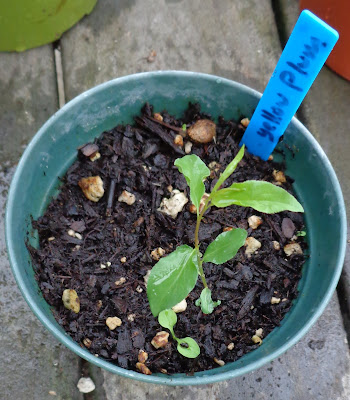These are heritage Irises from
Green Thumbs Galore in Chattanooga Tennessee. The variety pics are from their website - should be OK since I provide a link. I went Bonkers with irises this year. Not clear on where they will all be planted. These went into containers, for now.
New Irises are flashy, with bright, diverse colors and patterns, big flowers, and ruffles. Some are not great in the rain, becoming malformed globs of petals, and stalks that fall over. Fragrance has not been retained in hybridization, except for a few.
Heritage irises have simpler form, fewer more muted colors, and smaller flowers. This is a generalization that is not be 100% true. They are more likely to be Fragrant, I think. I hope the smaller simpler flowers and stems will hold up in the rain.
I consider this my "test garden". I plan to give away the ones I don't like. That may be a few years down the road. It's not so Darwinian with Irises. They don't die off, even with neglect. They may quit blooming, but so far I haven't had one variety die off. Some - just a couple - did not grow at the outset - all dried out rhizomes from big box stores, planted in late fall. One might have grown but was in a bad spot and hasn't bloomed yet in 3 years. I moved it, we'll see if that's the one, when it blooms.

The rhizomes arrived nicely packaged. They appear freshly dug, with no drying of leaf tips. The packaging was slightly moist but no mold or mildew. I get the feeling they were dug up for my order - nice thought. There were fewer roots and more top than some other orders - I don't think that's a problem, just a difference. Transplanting them from the humid summer of TN to the dry summer of WA, and the differences in soil and winter climate, they may have a bit of a shock.

No place set aside for them yet. Irises have limited root systems, so I planted in containers. As long as I keep them watered they should be OK. I can moved them into a sheltered spot this winter, if needed. If I get a location cleared and prepared, I'll move them into the ground. I'm curious about how they will do in containers, anyway. The largest really should go into the ground.

Loreley. Heritage Iris Preservation Society (HIPS) lists Loreley as developed in 1909. It appears to be a much smaller variety. Hybridized by "Goos & Koenemann"

Unknown Variety, "NoID" listed as "purple with silver beard, bitone".

Unknown Variety, "NoID" listed as "Lilac".

Helen Collingwood.
Heritage Iris Preservation Society (HIPS) has better pics. They list Helen as developed in 1949. It's big (40 inches) which is opposite of what I said about old varieties. Also very vigorous. No comment there about fragrence.
 The rhizomes arrived nicely packaged. They appear freshly dug, with no drying of leaf tips. The packaging was slightly moist but no mold or mildew. I get the feeling they were dug up for my order - nice thought. There were fewer roots and more top than some other orders - I don't think that's a problem, just a difference. Transplanting them from the humid summer of TN to the dry summer of WA, and the differences in soil and winter climate, they may have a bit of a shock.
The rhizomes arrived nicely packaged. They appear freshly dug, with no drying of leaf tips. The packaging was slightly moist but no mold or mildew. I get the feeling they were dug up for my order - nice thought. There were fewer roots and more top than some other orders - I don't think that's a problem, just a difference. Transplanting them from the humid summer of TN to the dry summer of WA, and the differences in soil and winter climate, they may have a bit of a shock.
 No place set aside for them yet. Irises have limited root systems, so I planted in containers. As long as I keep them watered they should be OK. I can moved them into a sheltered spot this winter, if needed. If I get a location cleared and prepared, I'll move them into the ground. I'm curious about how they will do in containers, anyway. The largest really should go into the ground.
No place set aside for them yet. Irises have limited root systems, so I planted in containers. As long as I keep them watered they should be OK. I can moved them into a sheltered spot this winter, if needed. If I get a location cleared and prepared, I'll move them into the ground. I'm curious about how they will do in containers, anyway. The largest really should go into the ground.
 Loreley. Heritage Iris Preservation Society (HIPS) lists Loreley as developed in 1909. It appears to be a much smaller variety. Hybridized by "Goos & Koenemann"
Loreley. Heritage Iris Preservation Society (HIPS) lists Loreley as developed in 1909. It appears to be a much smaller variety. Hybridized by "Goos & Koenemann"
 Unknown Variety, "NoID" listed as "purple with silver beard, bitone".
Unknown Variety, "NoID" listed as "purple with silver beard, bitone".
 Unknown Variety, "NoID" listed as "Lilac".
Unknown Variety, "NoID" listed as "Lilac".
 Helen Collingwood. Heritage Iris Preservation Society (HIPS) has better pics. They list Helen as developed in 1949. It's big (40 inches) which is opposite of what I said about old varieties. Also very vigorous. No comment there about fragrence.
Helen Collingwood. Heritage Iris Preservation Society (HIPS) has better pics. They list Helen as developed in 1949. It's big (40 inches) which is opposite of what I said about old varieties. Also very vigorous. No comment there about fragrence.









